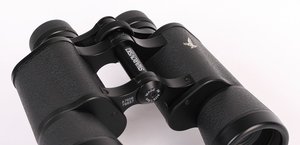Delta Optical Titanium 8x56 ROH
The Delta Optical company decided to accommodate these needs and offer a handy roof prism 8x56 model which, being not much more expensive, has similar optical properties. However, they didn’t follow the line of least resistance - they didn’t simply order something from a wide range of readily available models offered by Chinese plants and sold that under their own brand name. They chose a much more difficult process of ordering a project of a completely new equipment which, as a caseless prototype, came to Poland for preliminary tests. These tests showed some flaws which should have been eliminated in the final product. At the same time an outer binoculars casing was designed in Poland. Finally the company could influence the optical construction and the appearance of the new model of binoculars.
The device doesn’t deserve to be called „made in Poland” yet but it was certainly designed in our country and the producer boasts of that on the casing.
The binoculars are a small, handy roof prism Schmidt-Pechan instrument. The reflecting surface is supposed to be covered by enriched aluminum coatings. Apart from that all air-to-glass surfaces are multicoated.
The buyer gets objectives caps, joined eyepiece caps, a strap and a hard case in the box. The binoculars come with a 5-year guarantee.
| Magnification | Lens diameter | Angular field of view | Prisms | Eye relief | Weight | Price |
|---|---|---|---|---|---|---|
| 8 | 56 | 119/1000(6.8o) | BaK-4/roof | 24 mm | 990 g | 999 PLN |
Summary
Pros:
- very small, handy casing,
- good transmission,
- low distortion,
- sharp image in the most of field of view,
- correct colour rendering,
- good blackening inside the tubes,
- good quality of coatings and prisms,
- not very bothersome brightness loss on the edge of the field,
- sharp image already in the distance of less than 1.5 meters.
Cons:
- chromatic aberration is a bit too high.
 |
Let’s start with comparing the tested binoculars to their more expensive rivals which are equally handy and small.
The following chart will make it easier. Even near other “dwarves” in the 8x56 class the Delta remains the smallest and, along with the Conquest, physically the lightest. What’s important the Titanium also features the widest field of view of all instruments in this group!
Let’s glance on a comparison to other roof prism binoculars from a similar price/quality segment – you can find it presented in the next chart. Once again the compactness and low weight of the Delta are conspicuous. It’s worth noticing though that it stopped being the leader of the field of view category because the Eschenbach has a bigger field than the device tested here.
The photo below shows the Delta next to the Steiner Night Hunter Xtreme 8x56 – a Porro pair of binoculars which belongs to the group of smaller devices in this equipment class.
 Delta Optical Titanium 8x56 (left) and Steiner Night Hunter 8x56 Xtreme (right). |
Let’s start with the flaws perhaps. The biggest flaw, but not an especially serious one, is, in our opinion, the chromatic aberration. Small dimensions of the binoculars forced the usage of a fast objective lens which didn’t manage to correct that aberration completely. Its level is perhaps not huge but in the centre of the image its influence is noticeably and, in some situations, even annoying.
We can carp a bit about the build quality. There is too much grease near eyepieces and in the joints of tubes, the edges of the metal casing close to objectives are scratched. The binoculars make an impression of a very solid instrument for a change, it is very well blackened and we haven’t noticed much dirt inside.
The transmission, as you can see on the graph below, is perhaps not record-breaking but you shouldn’t complain about it either.
 |
Some small reservations could have been expressed if you had dealt with an instrument at higher price point – that of 1000 USD. However, you have here a roof prism set of binoculars produced in China which costs less than 300 USD so you shouldn’t expect any miracles. For such price/quality segment the transmission is really good anyway.
The binoculars don’t have any serious slip-ups. In many categories they fare moderately well (coma, astigmatism, chromatic aberration) and in many others – quite well (distortion, resolution on the edge of the field, colour rendition, the shape of pupils). The shape of exit pupils should be especially emphasized here - they are almost perfectly round with hardly any cuts and no distinct vignetting. It is a huge achievement, taking into account the dimensions of the whole device. When you also consider the price/quality ratio, the field of view, which is quite good for such a class of instruments, and the smallest dimensions available on the market you must admit this is a very interesting pair of binoculars, especially for those who appreciate low weight and the handiness of their equipment.
The roof prism 8x56 got a final result not much worse than that of much-praised Porro prism Titanium 8x56. The tested device is more expensive, being a compact roof prism instrument after all, but certainly not so expensive you shouldn’t consider buying it. Quite the opposite – it seems that for such a price you can recommend it to anyone who, for a reason or two doesn’t want to buy a Porro pair of binoculars.
To sum up we are very pleased another pair of binoculars worth interest appeared on the market. As you can notice consulting the following chart the line-up of Delta Optical features quite a nice collection of well done 8x56 pairs of binoculars. You can pick and choose…


















